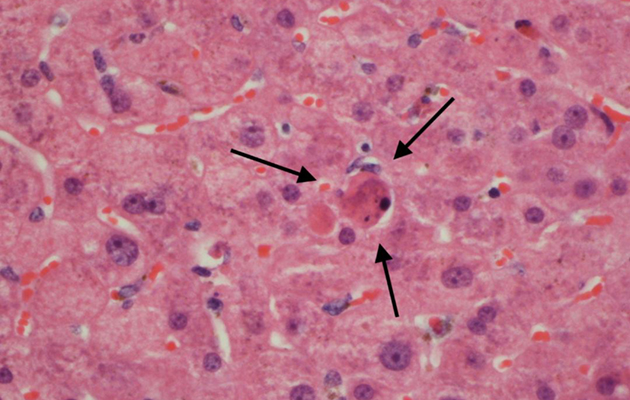Liver disease is a relatively common equine medical problem, yet horses with the condition tend to hide it well. This multi tasking organ has a huge reserve capacity, which means that a significant proportion of the liver may be damaged before outward signs of illness become apparent.
A vet will suspect liver disease on seeing evidence of liver failure, such as wobbliness, weight loss, lethargy and increased drinking and urinating. Another very visible sign is excessive sunburn of non-pigmented skin and white-haired areas, known as photosensitisation.
Blood samples taken to confirm the vet’s suspicions may reveal elevations in liver enzyme concentrations. In these cases, where the horse is showing obvious clinical signs, severe liver disease is present.
Ideally, disease is detected at an early stage before the liver suffers irreversible damage. At this point, there is the potential for successful treatment and a better prospect of long-term survival. This is why a vet may suggest checking for liver disease alongside other conditions, when the horse shows vague signs of “not being quite himself” or is performing below expectations.

While liver disease has traditionally been seen as a single-horse problem, vets now recognise that outbreaks are common. In fact, it is more likely that a group of horses will be affected than an individual — which is why it is important that other horses on the same premises are investigated whenever liver disease of any severity is diagnosed.
Your vet may recommend testing a few liver parameters on blood samples taken from horses sharing similar management, even if they appear healthy. This usually costs no more than £10 to £25 per horse and is a wise investment, because disease left undiagnosed may eventually result in permanent liver damage.
It is also useful for your vet to be aware of liver disease affecting a whole group. The best treatment can then be selected and specific management changes implemented to help resolve the problem.
Fungal facts
Toxic or infectious causes are most likely when liver disease occurs as an outbreak.
The best-known cause is ragwort toxicity, from eating the plants fresh from pasture or dried in forage. It is often assumed that all liver disease is caused by ragwort, yet recent surveys of owners, vets, and pathologists showed that properly confirmed cases of ragwort toxicity are in fact very rare.
Eating excessive amounts of iron should also be considered as a possible toxic cause. This could be from tonics and supplements or high concentrations of iron in water, soil or forage.
It is extremely uncommon for horses to be deficient in this mineral, yet many supplements and “go-faster” or “pick-me-up” tonics contain extra iron. If a liver disease outbreak is detected, your vet may check any supplements you are using in case excessive iron intake has resulted in toxic accumulation. A liver biopsy will highlight a severe iron overload, known as haemosiderosis.
Fungal toxins — called mycotoxins — in forage can also cause liver damage. Recent research from Liphook Equine Hospital, where I am an internal medicine specialist, compared hay from yards with liver disease outbreaks with hay from premises where routine blood tests found no evidence of disease. More than 30% of the hay samples from the affected yards contained Fumonisin B1, a known liver toxin, whereas samples from the disease-free yards were clear.
Your vet may advise that you change your source of hay if it appears that the horses eating it have a liver problem. It is possible to test hay for mycotoxins. Blood test results from affected horses will usually return to normal within a few weeks once the source of mycotoxin has been removed.

Going viral
While we know that viruses can cause liver disease in many other species, this has not been looked at in detail in the horse until very recently.
Two new viruses — equine hepacivirus and equine parvovirus-hepatitis — have been discovered in the USA, but the exact relevance of these to outbreaks of liver disease in the UK horse population is not yet fully understood. Liphook Equine Hospital researchers are working on several projects involving these viruses to help improve our knowledge in this area.
Liver fluke is a relatively rare cause of liver disease in the horse, but it may be suspected in the case of an outbreak if there is a known fluke problem in sheep and cattle grazing on the same pasture.
It is difficult to make a confident diagnosis in a live horse because the fluke parasite can be present in the liver without shedding eggs in the faeces — and fluke antibody blood tests in horses are not reliable. A liver biopsy will occasionally show changes suggestive of fluke infection. Your vet may recommend specific anti-fluke medication if this is suspected as a possible cause of disease.
Ongoing research into these various fungal toxin and viral causes should give us a greater understanding of equine liver disease outbreaks in the UK. What is certain is that the stable and field mates of any affected horse should be screened to gauge the full extent of the problem.
Ref Horse & Hound; 3 May 2018

